Fruitly Marketing Report: Non-Alcoholic Beer Market Analysis
VerifiedAdded on 2023/06/04
|12
|3602
|198
Report
AI Summary
This marketing report focuses on Fruitly, a non-alcoholic fruit-based beer, analyzing its market strategy. The report begins with an executive summary and introduction, followed by an industry overview, assessing the beverage market's growth and consumer preferences for non-alcoholic options. It then explores the macro-environment using the PESTLE framework, examining political, economic, social, technological, environmental, and legal factors impacting Fruitly. The report continues with an STP analysis, including segmentation based on demographics, geography, and behavior; targeting specific customer groups; and positioning Fruitly in the market. Finally, it outlines the marketing mix, providing recommendations to effectively promote and sell the product. The report concludes with a summary of findings and a list of references.
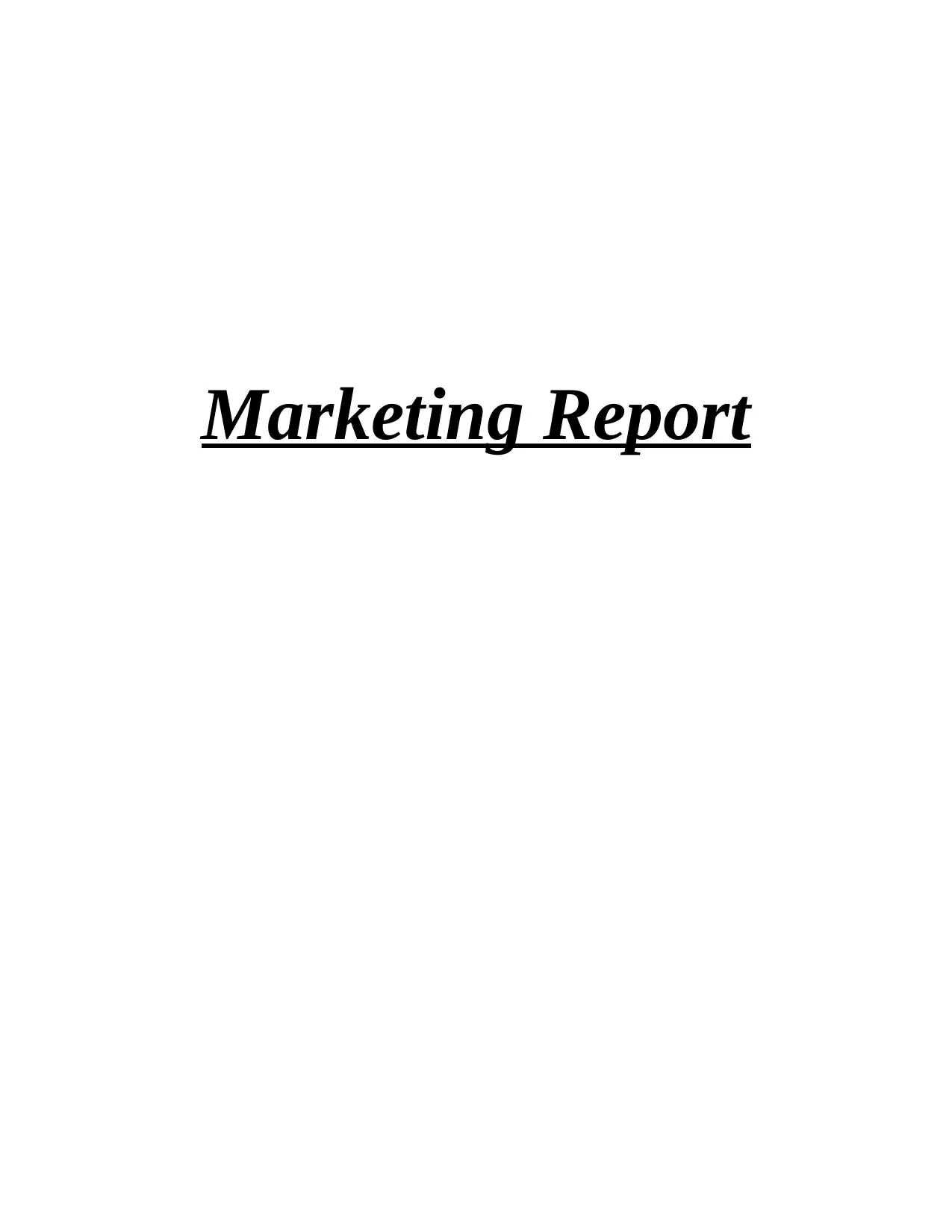
Marketing Report
Paraphrase This Document
Need a fresh take? Get an instant paraphrase of this document with our AI Paraphraser
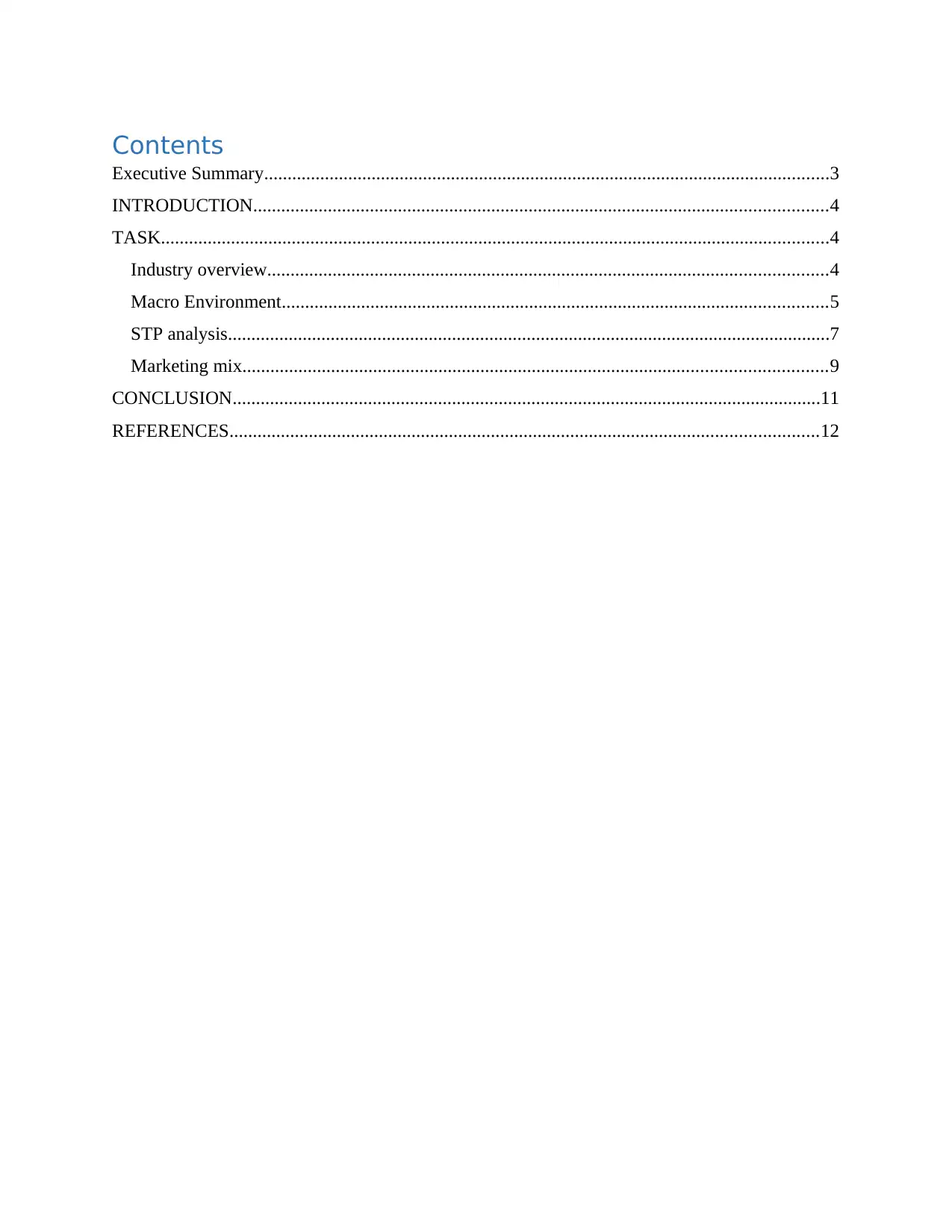
Contents
Executive Summary.........................................................................................................................3
INTRODUCTION...........................................................................................................................4
TASK...............................................................................................................................................4
Industry overview........................................................................................................................4
Macro Environment.....................................................................................................................5
STP analysis.................................................................................................................................7
Marketing mix.............................................................................................................................9
CONCLUSION..............................................................................................................................11
REFERENCES..............................................................................................................................12
Executive Summary.........................................................................................................................3
INTRODUCTION...........................................................................................................................4
TASK...............................................................................................................................................4
Industry overview........................................................................................................................4
Macro Environment.....................................................................................................................5
STP analysis.................................................................................................................................7
Marketing mix.............................................................................................................................9
CONCLUSION..............................................................................................................................11
REFERENCES..............................................................................................................................12
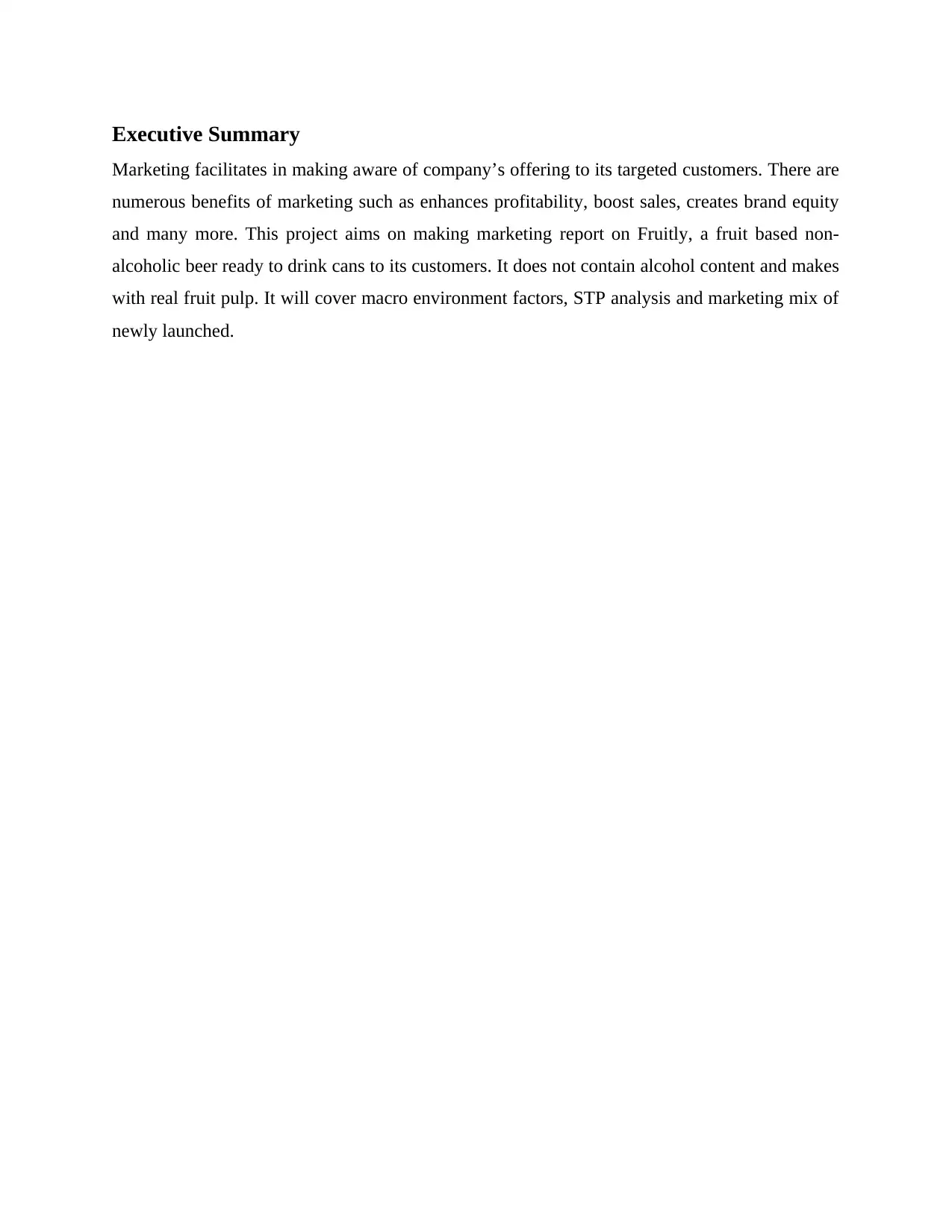
Executive Summary
Marketing facilitates in making aware of company’s offering to its targeted customers. There are
numerous benefits of marketing such as enhances profitability, boost sales, creates brand equity
and many more. This project aims on making marketing report on Fruitly, a fruit based non-
alcoholic beer ready to drink cans to its customers. It does not contain alcohol content and makes
with real fruit pulp. It will cover macro environment factors, STP analysis and marketing mix of
newly launched.
Marketing facilitates in making aware of company’s offering to its targeted customers. There are
numerous benefits of marketing such as enhances profitability, boost sales, creates brand equity
and many more. This project aims on making marketing report on Fruitly, a fruit based non-
alcoholic beer ready to drink cans to its customers. It does not contain alcohol content and makes
with real fruit pulp. It will cover macro environment factors, STP analysis and marketing mix of
newly launched.
⊘ This is a preview!⊘
Do you want full access?
Subscribe today to unlock all pages.

Trusted by 1+ million students worldwide
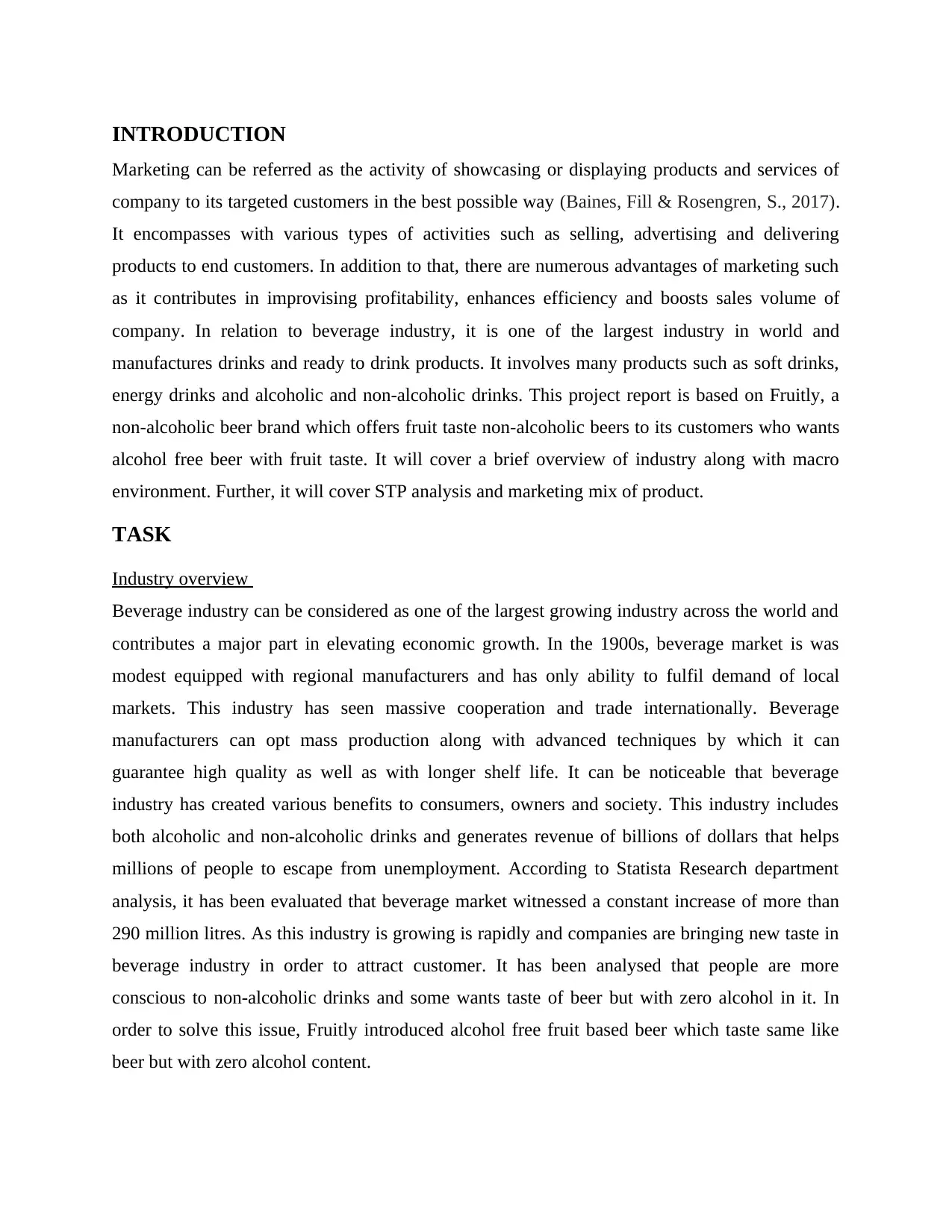
INTRODUCTION
Marketing can be referred as the activity of showcasing or displaying products and services of
company to its targeted customers in the best possible way (Baines, Fill & Rosengren, S., 2017).
It encompasses with various types of activities such as selling, advertising and delivering
products to end customers. In addition to that, there are numerous advantages of marketing such
as it contributes in improvising profitability, enhances efficiency and boosts sales volume of
company. In relation to beverage industry, it is one of the largest industry in world and
manufactures drinks and ready to drink products. It involves many products such as soft drinks,
energy drinks and alcoholic and non-alcoholic drinks. This project report is based on Fruitly, a
non-alcoholic beer brand which offers fruit taste non-alcoholic beers to its customers who wants
alcohol free beer with fruit taste. It will cover a brief overview of industry along with macro
environment. Further, it will cover STP analysis and marketing mix of product.
TASK
Industry overview
Beverage industry can be considered as one of the largest growing industry across the world and
contributes a major part in elevating economic growth. In the 1900s, beverage market is was
modest equipped with regional manufacturers and has only ability to fulfil demand of local
markets. This industry has seen massive cooperation and trade internationally. Beverage
manufacturers can opt mass production along with advanced techniques by which it can
guarantee high quality as well as with longer shelf life. It can be noticeable that beverage
industry has created various benefits to consumers, owners and society. This industry includes
both alcoholic and non-alcoholic drinks and generates revenue of billions of dollars that helps
millions of people to escape from unemployment. According to Statista Research department
analysis, it has been evaluated that beverage market witnessed a constant increase of more than
290 million litres. As this industry is growing is rapidly and companies are bringing new taste in
beverage industry in order to attract customer. It has been analysed that people are more
conscious to non-alcoholic drinks and some wants taste of beer but with zero alcohol in it. In
order to solve this issue, Fruitly introduced alcohol free fruit based beer which taste same like
beer but with zero alcohol content.
Marketing can be referred as the activity of showcasing or displaying products and services of
company to its targeted customers in the best possible way (Baines, Fill & Rosengren, S., 2017).
It encompasses with various types of activities such as selling, advertising and delivering
products to end customers. In addition to that, there are numerous advantages of marketing such
as it contributes in improvising profitability, enhances efficiency and boosts sales volume of
company. In relation to beverage industry, it is one of the largest industry in world and
manufactures drinks and ready to drink products. It involves many products such as soft drinks,
energy drinks and alcoholic and non-alcoholic drinks. This project report is based on Fruitly, a
non-alcoholic beer brand which offers fruit taste non-alcoholic beers to its customers who wants
alcohol free beer with fruit taste. It will cover a brief overview of industry along with macro
environment. Further, it will cover STP analysis and marketing mix of product.
TASK
Industry overview
Beverage industry can be considered as one of the largest growing industry across the world and
contributes a major part in elevating economic growth. In the 1900s, beverage market is was
modest equipped with regional manufacturers and has only ability to fulfil demand of local
markets. This industry has seen massive cooperation and trade internationally. Beverage
manufacturers can opt mass production along with advanced techniques by which it can
guarantee high quality as well as with longer shelf life. It can be noticeable that beverage
industry has created various benefits to consumers, owners and society. This industry includes
both alcoholic and non-alcoholic drinks and generates revenue of billions of dollars that helps
millions of people to escape from unemployment. According to Statista Research department
analysis, it has been evaluated that beverage market witnessed a constant increase of more than
290 million litres. As this industry is growing is rapidly and companies are bringing new taste in
beverage industry in order to attract customer. It has been analysed that people are more
conscious to non-alcoholic drinks and some wants taste of beer but with zero alcohol in it. In
order to solve this issue, Fruitly introduced alcohol free fruit based beer which taste same like
beer but with zero alcohol content.
Paraphrase This Document
Need a fresh take? Get an instant paraphrase of this document with our AI Paraphraser
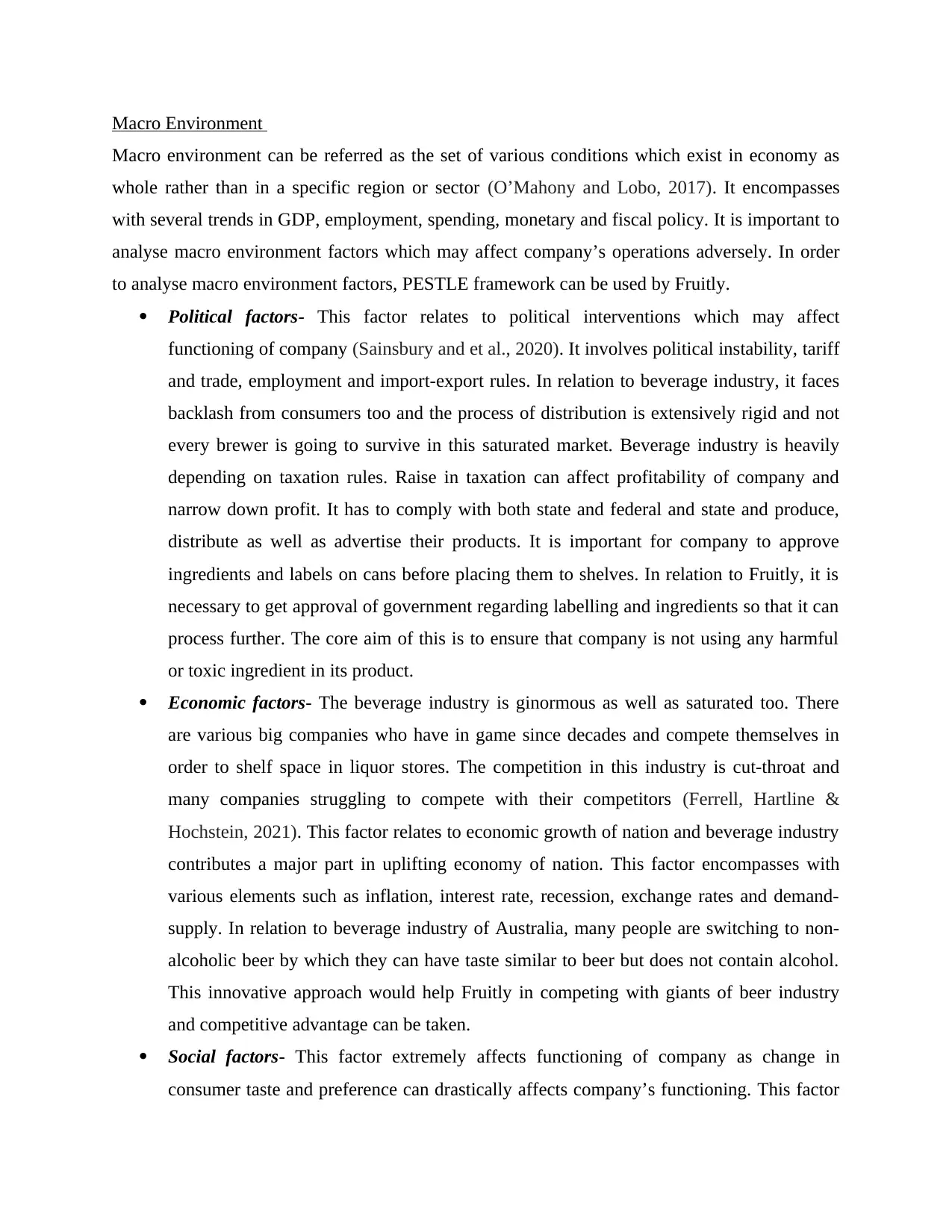
Macro Environment
Macro environment can be referred as the set of various conditions which exist in economy as
whole rather than in a specific region or sector (O’Mahony and Lobo, 2017). It encompasses
with several trends in GDP, employment, spending, monetary and fiscal policy. It is important to
analyse macro environment factors which may affect company’s operations adversely. In order
to analyse macro environment factors, PESTLE framework can be used by Fruitly.
Political factors- This factor relates to political interventions which may affect
functioning of company (Sainsbury and et al., 2020). It involves political instability, tariff
and trade, employment and import-export rules. In relation to beverage industry, it faces
backlash from consumers too and the process of distribution is extensively rigid and not
every brewer is going to survive in this saturated market. Beverage industry is heavily
depending on taxation rules. Raise in taxation can affect profitability of company and
narrow down profit. It has to comply with both state and federal and state and produce,
distribute as well as advertise their products. It is important for company to approve
ingredients and labels on cans before placing them to shelves. In relation to Fruitly, it is
necessary to get approval of government regarding labelling and ingredients so that it can
process further. The core aim of this is to ensure that company is not using any harmful
or toxic ingredient in its product.
Economic factors- The beverage industry is ginormous as well as saturated too. There
are various big companies who have in game since decades and compete themselves in
order to shelf space in liquor stores. The competition in this industry is cut-throat and
many companies struggling to compete with their competitors (Ferrell, Hartline &
Hochstein, 2021). This factor relates to economic growth of nation and beverage industry
contributes a major part in uplifting economy of nation. This factor encompasses with
various elements such as inflation, interest rate, recession, exchange rates and demand-
supply. In relation to beverage industry of Australia, many people are switching to non-
alcoholic beer by which they can have taste similar to beer but does not contain alcohol.
This innovative approach would help Fruitly in competing with giants of beer industry
and competitive advantage can be taken.
Social factors- This factor extremely affects functioning of company as change in
consumer taste and preference can drastically affects company’s functioning. This factor
Macro environment can be referred as the set of various conditions which exist in economy as
whole rather than in a specific region or sector (O’Mahony and Lobo, 2017). It encompasses
with several trends in GDP, employment, spending, monetary and fiscal policy. It is important to
analyse macro environment factors which may affect company’s operations adversely. In order
to analyse macro environment factors, PESTLE framework can be used by Fruitly.
Political factors- This factor relates to political interventions which may affect
functioning of company (Sainsbury and et al., 2020). It involves political instability, tariff
and trade, employment and import-export rules. In relation to beverage industry, it faces
backlash from consumers too and the process of distribution is extensively rigid and not
every brewer is going to survive in this saturated market. Beverage industry is heavily
depending on taxation rules. Raise in taxation can affect profitability of company and
narrow down profit. It has to comply with both state and federal and state and produce,
distribute as well as advertise their products. It is important for company to approve
ingredients and labels on cans before placing them to shelves. In relation to Fruitly, it is
necessary to get approval of government regarding labelling and ingredients so that it can
process further. The core aim of this is to ensure that company is not using any harmful
or toxic ingredient in its product.
Economic factors- The beverage industry is ginormous as well as saturated too. There
are various big companies who have in game since decades and compete themselves in
order to shelf space in liquor stores. The competition in this industry is cut-throat and
many companies struggling to compete with their competitors (Ferrell, Hartline &
Hochstein, 2021). This factor relates to economic growth of nation and beverage industry
contributes a major part in uplifting economy of nation. This factor encompasses with
various elements such as inflation, interest rate, recession, exchange rates and demand-
supply. In relation to beverage industry of Australia, many people are switching to non-
alcoholic beer by which they can have taste similar to beer but does not contain alcohol.
This innovative approach would help Fruitly in competing with giants of beer industry
and competitive advantage can be taken.
Social factors- This factor extremely affects functioning of company as change in
consumer taste and preference can drastically affects company’s functioning. This factor
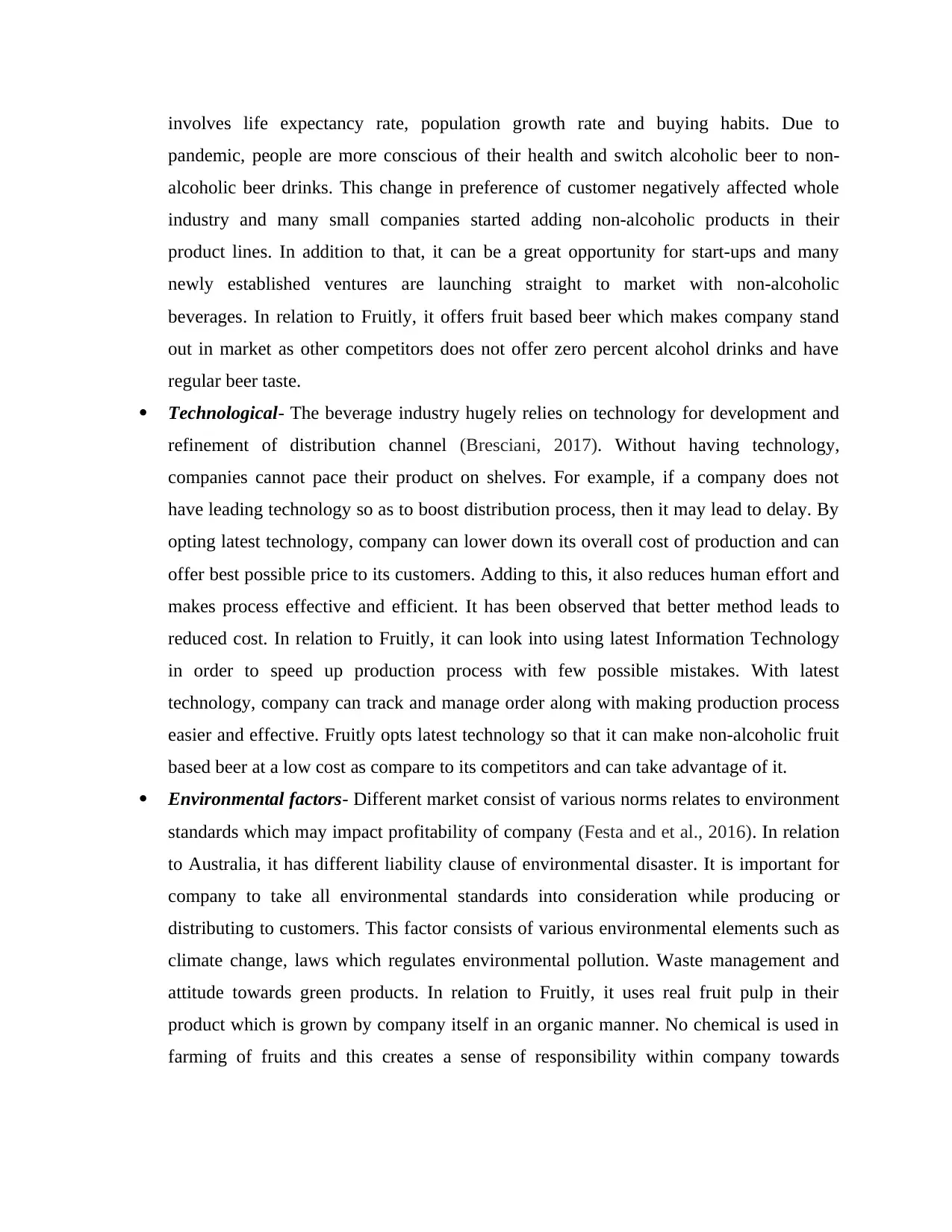
involves life expectancy rate, population growth rate and buying habits. Due to
pandemic, people are more conscious of their health and switch alcoholic beer to non-
alcoholic beer drinks. This change in preference of customer negatively affected whole
industry and many small companies started adding non-alcoholic products in their
product lines. In addition to that, it can be a great opportunity for start-ups and many
newly established ventures are launching straight to market with non-alcoholic
beverages. In relation to Fruitly, it offers fruit based beer which makes company stand
out in market as other competitors does not offer zero percent alcohol drinks and have
regular beer taste.
Technological- The beverage industry hugely relies on technology for development and
refinement of distribution channel (Bresciani, 2017). Without having technology,
companies cannot pace their product on shelves. For example, if a company does not
have leading technology so as to boost distribution process, then it may lead to delay. By
opting latest technology, company can lower down its overall cost of production and can
offer best possible price to its customers. Adding to this, it also reduces human effort and
makes process effective and efficient. It has been observed that better method leads to
reduced cost. In relation to Fruitly, it can look into using latest Information Technology
in order to speed up production process with few possible mistakes. With latest
technology, company can track and manage order along with making production process
easier and effective. Fruitly opts latest technology so that it can make non-alcoholic fruit
based beer at a low cost as compare to its competitors and can take advantage of it.
Environmental factors- Different market consist of various norms relates to environment
standards which may impact profitability of company (Festa and et al., 2016). In relation
to Australia, it has different liability clause of environmental disaster. It is important for
company to take all environmental standards into consideration while producing or
distributing to customers. This factor consists of various environmental elements such as
climate change, laws which regulates environmental pollution. Waste management and
attitude towards green products. In relation to Fruitly, it uses real fruit pulp in their
product which is grown by company itself in an organic manner. No chemical is used in
farming of fruits and this creates a sense of responsibility within company towards
pandemic, people are more conscious of their health and switch alcoholic beer to non-
alcoholic beer drinks. This change in preference of customer negatively affected whole
industry and many small companies started adding non-alcoholic products in their
product lines. In addition to that, it can be a great opportunity for start-ups and many
newly established ventures are launching straight to market with non-alcoholic
beverages. In relation to Fruitly, it offers fruit based beer which makes company stand
out in market as other competitors does not offer zero percent alcohol drinks and have
regular beer taste.
Technological- The beverage industry hugely relies on technology for development and
refinement of distribution channel (Bresciani, 2017). Without having technology,
companies cannot pace their product on shelves. For example, if a company does not
have leading technology so as to boost distribution process, then it may lead to delay. By
opting latest technology, company can lower down its overall cost of production and can
offer best possible price to its customers. Adding to this, it also reduces human effort and
makes process effective and efficient. It has been observed that better method leads to
reduced cost. In relation to Fruitly, it can look into using latest Information Technology
in order to speed up production process with few possible mistakes. With latest
technology, company can track and manage order along with making production process
easier and effective. Fruitly opts latest technology so that it can make non-alcoholic fruit
based beer at a low cost as compare to its competitors and can take advantage of it.
Environmental factors- Different market consist of various norms relates to environment
standards which may impact profitability of company (Festa and et al., 2016). In relation
to Australia, it has different liability clause of environmental disaster. It is important for
company to take all environmental standards into consideration while producing or
distributing to customers. This factor consists of various environmental elements such as
climate change, laws which regulates environmental pollution. Waste management and
attitude towards green products. In relation to Fruitly, it uses real fruit pulp in their
product which is grown by company itself in an organic manner. No chemical is used in
farming of fruits and this creates a sense of responsibility within company towards
⊘ This is a preview!⊘
Do you want full access?
Subscribe today to unlock all pages.

Trusted by 1+ million students worldwide
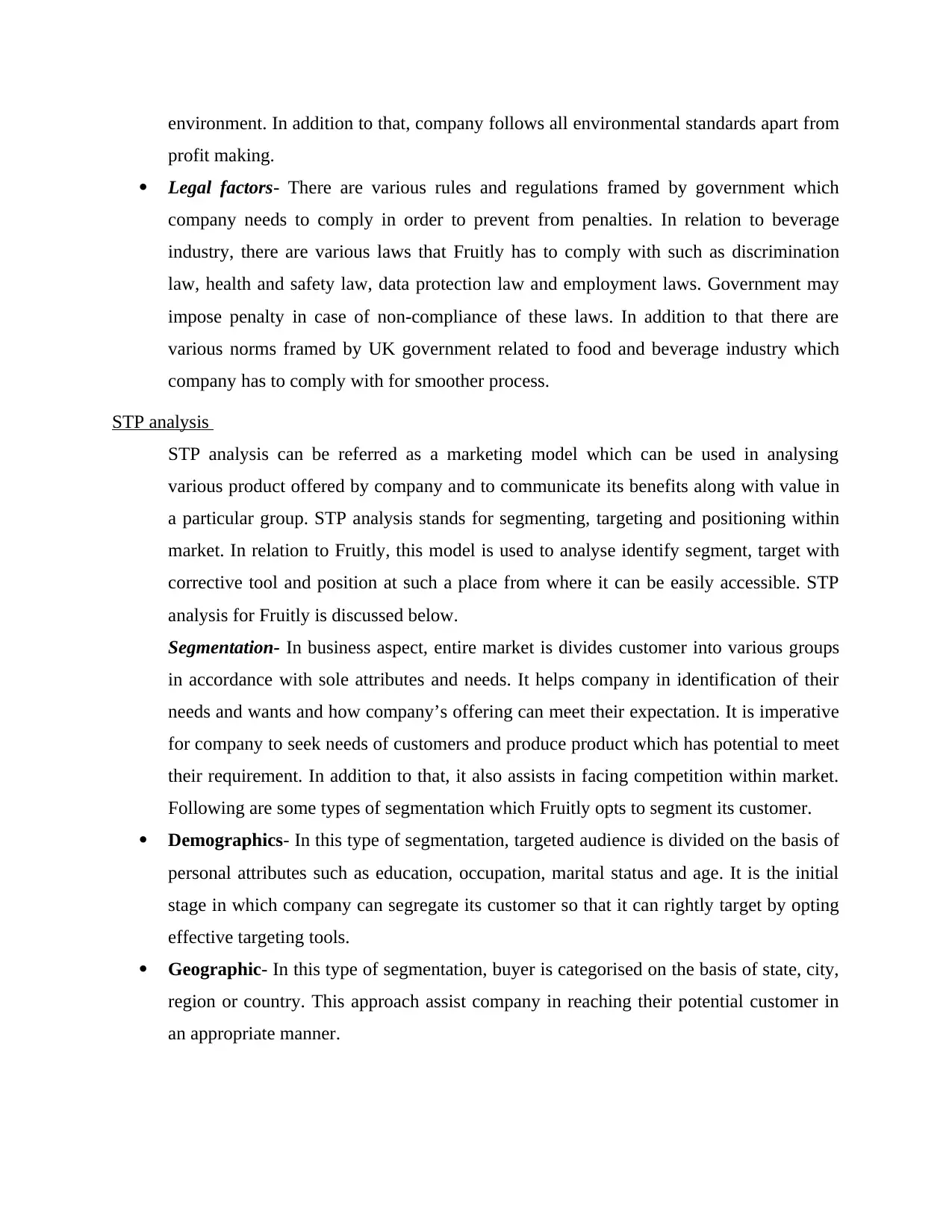
environment. In addition to that, company follows all environmental standards apart from
profit making.
Legal factors- There are various rules and regulations framed by government which
company needs to comply in order to prevent from penalties. In relation to beverage
industry, there are various laws that Fruitly has to comply with such as discrimination
law, health and safety law, data protection law and employment laws. Government may
impose penalty in case of non-compliance of these laws. In addition to that there are
various norms framed by UK government related to food and beverage industry which
company has to comply with for smoother process.
STP analysis
STP analysis can be referred as a marketing model which can be used in analysing
various product offered by company and to communicate its benefits along with value in
a particular group. STP analysis stands for segmenting, targeting and positioning within
market. In relation to Fruitly, this model is used to analyse identify segment, target with
corrective tool and position at such a place from where it can be easily accessible. STP
analysis for Fruitly is discussed below.
Segmentation- In business aspect, entire market is divides customer into various groups
in accordance with sole attributes and needs. It helps company in identification of their
needs and wants and how company’s offering can meet their expectation. It is imperative
for company to seek needs of customers and produce product which has potential to meet
their requirement. In addition to that, it also assists in facing competition within market.
Following are some types of segmentation which Fruitly opts to segment its customer.
Demographics- In this type of segmentation, targeted audience is divided on the basis of
personal attributes such as education, occupation, marital status and age. It is the initial
stage in which company can segregate its customer so that it can rightly target by opting
effective targeting tools.
Geographic- In this type of segmentation, buyer is categorised on the basis of state, city,
region or country. This approach assist company in reaching their potential customer in
an appropriate manner.
profit making.
Legal factors- There are various rules and regulations framed by government which
company needs to comply in order to prevent from penalties. In relation to beverage
industry, there are various laws that Fruitly has to comply with such as discrimination
law, health and safety law, data protection law and employment laws. Government may
impose penalty in case of non-compliance of these laws. In addition to that there are
various norms framed by UK government related to food and beverage industry which
company has to comply with for smoother process.
STP analysis
STP analysis can be referred as a marketing model which can be used in analysing
various product offered by company and to communicate its benefits along with value in
a particular group. STP analysis stands for segmenting, targeting and positioning within
market. In relation to Fruitly, this model is used to analyse identify segment, target with
corrective tool and position at such a place from where it can be easily accessible. STP
analysis for Fruitly is discussed below.
Segmentation- In business aspect, entire market is divides customer into various groups
in accordance with sole attributes and needs. It helps company in identification of their
needs and wants and how company’s offering can meet their expectation. It is imperative
for company to seek needs of customers and produce product which has potential to meet
their requirement. In addition to that, it also assists in facing competition within market.
Following are some types of segmentation which Fruitly opts to segment its customer.
Demographics- In this type of segmentation, targeted audience is divided on the basis of
personal attributes such as education, occupation, marital status and age. It is the initial
stage in which company can segregate its customer so that it can rightly target by opting
effective targeting tools.
Geographic- In this type of segmentation, buyer is categorised on the basis of state, city,
region or country. This approach assist company in reaching their potential customer in
an appropriate manner.
Paraphrase This Document
Need a fresh take? Get an instant paraphrase of this document with our AI Paraphraser
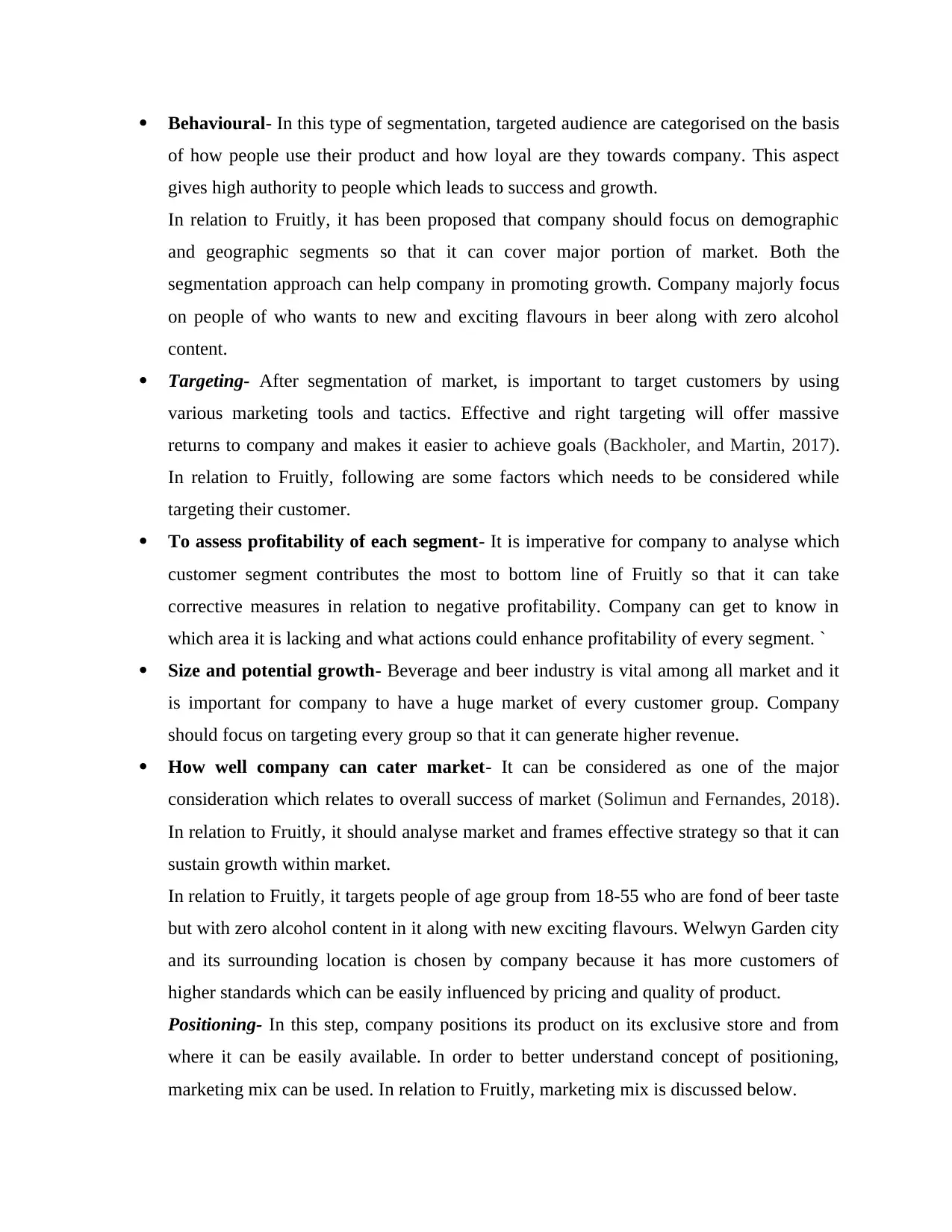
Behavioural- In this type of segmentation, targeted audience are categorised on the basis
of how people use their product and how loyal are they towards company. This aspect
gives high authority to people which leads to success and growth.
In relation to Fruitly, it has been proposed that company should focus on demographic
and geographic segments so that it can cover major portion of market. Both the
segmentation approach can help company in promoting growth. Company majorly focus
on people of who wants to new and exciting flavours in beer along with zero alcohol
content.
Targeting- After segmentation of market, is important to target customers by using
various marketing tools and tactics. Effective and right targeting will offer massive
returns to company and makes it easier to achieve goals (Backholer, and Martin, 2017).
In relation to Fruitly, following are some factors which needs to be considered while
targeting their customer.
To assess profitability of each segment- It is imperative for company to analyse which
customer segment contributes the most to bottom line of Fruitly so that it can take
corrective measures in relation to negative profitability. Company can get to know in
which area it is lacking and what actions could enhance profitability of every segment. `
Size and potential growth- Beverage and beer industry is vital among all market and it
is important for company to have a huge market of every customer group. Company
should focus on targeting every group so that it can generate higher revenue.
How well company can cater market- It can be considered as one of the major
consideration which relates to overall success of market (Solimun and Fernandes, 2018).
In relation to Fruitly, it should analyse market and frames effective strategy so that it can
sustain growth within market.
In relation to Fruitly, it targets people of age group from 18-55 who are fond of beer taste
but with zero alcohol content in it along with new exciting flavours. Welwyn Garden city
and its surrounding location is chosen by company because it has more customers of
higher standards which can be easily influenced by pricing and quality of product.
Positioning- In this step, company positions its product on its exclusive store and from
where it can be easily available. In order to better understand concept of positioning,
marketing mix can be used. In relation to Fruitly, marketing mix is discussed below.
of how people use their product and how loyal are they towards company. This aspect
gives high authority to people which leads to success and growth.
In relation to Fruitly, it has been proposed that company should focus on demographic
and geographic segments so that it can cover major portion of market. Both the
segmentation approach can help company in promoting growth. Company majorly focus
on people of who wants to new and exciting flavours in beer along with zero alcohol
content.
Targeting- After segmentation of market, is important to target customers by using
various marketing tools and tactics. Effective and right targeting will offer massive
returns to company and makes it easier to achieve goals (Backholer, and Martin, 2017).
In relation to Fruitly, following are some factors which needs to be considered while
targeting their customer.
To assess profitability of each segment- It is imperative for company to analyse which
customer segment contributes the most to bottom line of Fruitly so that it can take
corrective measures in relation to negative profitability. Company can get to know in
which area it is lacking and what actions could enhance profitability of every segment. `
Size and potential growth- Beverage and beer industry is vital among all market and it
is important for company to have a huge market of every customer group. Company
should focus on targeting every group so that it can generate higher revenue.
How well company can cater market- It can be considered as one of the major
consideration which relates to overall success of market (Solimun and Fernandes, 2018).
In relation to Fruitly, it should analyse market and frames effective strategy so that it can
sustain growth within market.
In relation to Fruitly, it targets people of age group from 18-55 who are fond of beer taste
but with zero alcohol content in it along with new exciting flavours. Welwyn Garden city
and its surrounding location is chosen by company because it has more customers of
higher standards which can be easily influenced by pricing and quality of product.
Positioning- In this step, company positions its product on its exclusive store and from
where it can be easily available. In order to better understand concept of positioning,
marketing mix can be used. In relation to Fruitly, marketing mix is discussed below.
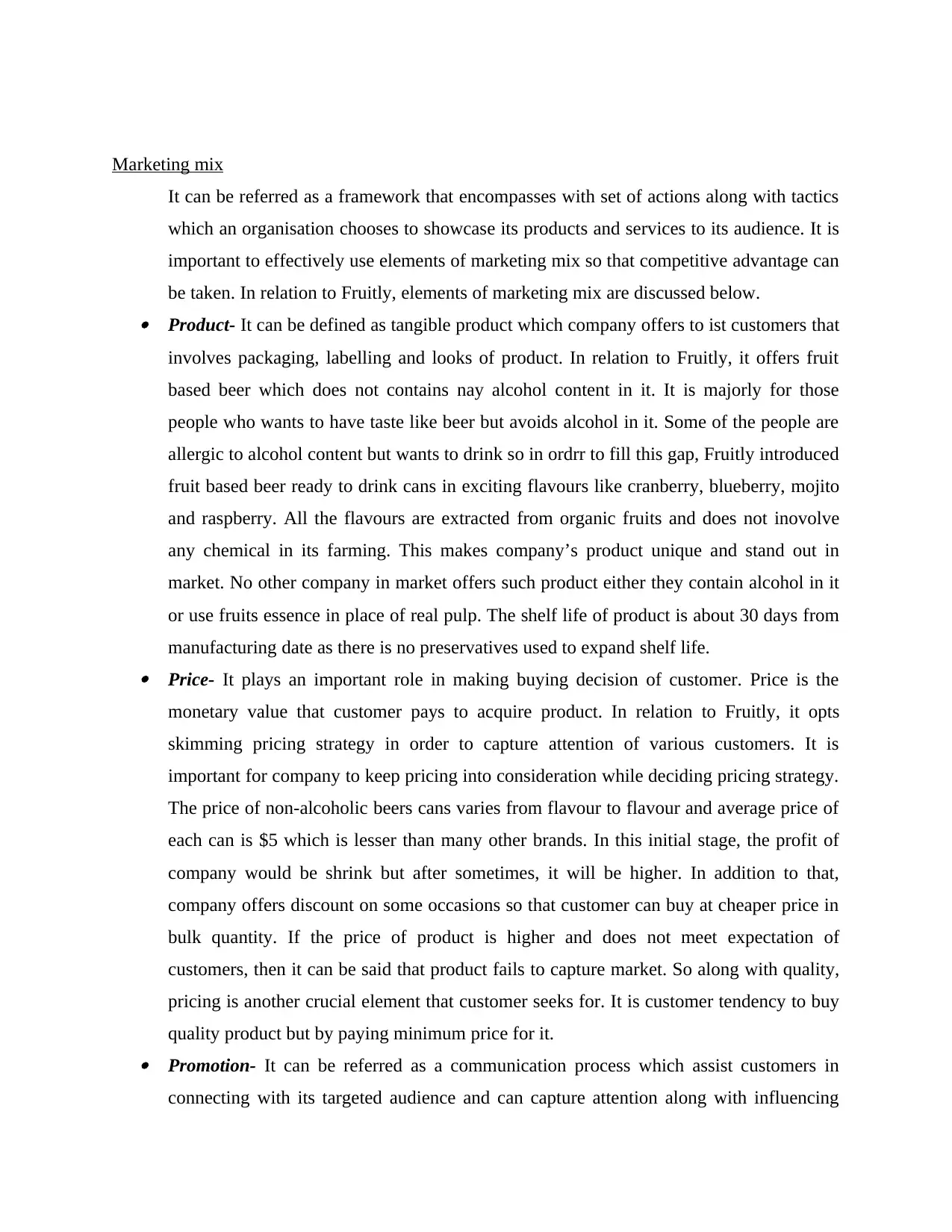
Marketing mix
It can be referred as a framework that encompasses with set of actions along with tactics
which an organisation chooses to showcase its products and services to its audience. It is
important to effectively use elements of marketing mix so that competitive advantage can
be taken. In relation to Fruitly, elements of marketing mix are discussed below. Product- It can be defined as tangible product which company offers to ist customers that
involves packaging, labelling and looks of product. In relation to Fruitly, it offers fruit
based beer which does not contains nay alcohol content in it. It is majorly for those
people who wants to have taste like beer but avoids alcohol in it. Some of the people are
allergic to alcohol content but wants to drink so in ordrr to fill this gap, Fruitly introduced
fruit based beer ready to drink cans in exciting flavours like cranberry, blueberry, mojito
and raspberry. All the flavours are extracted from organic fruits and does not inovolve
any chemical in its farming. This makes company’s product unique and stand out in
market. No other company in market offers such product either they contain alcohol in it
or use fruits essence in place of real pulp. The shelf life of product is about 30 days from
manufacturing date as there is no preservatives used to expand shelf life. Price- It plays an important role in making buying decision of customer. Price is the
monetary value that customer pays to acquire product. In relation to Fruitly, it opts
skimming pricing strategy in order to capture attention of various customers. It is
important for company to keep pricing into consideration while deciding pricing strategy.
The price of non-alcoholic beers cans varies from flavour to flavour and average price of
each can is $5 which is lesser than many other brands. In this initial stage, the profit of
company would be shrink but after sometimes, it will be higher. In addition to that,
company offers discount on some occasions so that customer can buy at cheaper price in
bulk quantity. If the price of product is higher and does not meet expectation of
customers, then it can be said that product fails to capture market. So along with quality,
pricing is another crucial element that customer seeks for. It is customer tendency to buy
quality product but by paying minimum price for it. Promotion- It can be referred as a communication process which assist customers in
connecting with its targeted audience and can capture attention along with influencing
It can be referred as a framework that encompasses with set of actions along with tactics
which an organisation chooses to showcase its products and services to its audience. It is
important to effectively use elements of marketing mix so that competitive advantage can
be taken. In relation to Fruitly, elements of marketing mix are discussed below. Product- It can be defined as tangible product which company offers to ist customers that
involves packaging, labelling and looks of product. In relation to Fruitly, it offers fruit
based beer which does not contains nay alcohol content in it. It is majorly for those
people who wants to have taste like beer but avoids alcohol in it. Some of the people are
allergic to alcohol content but wants to drink so in ordrr to fill this gap, Fruitly introduced
fruit based beer ready to drink cans in exciting flavours like cranberry, blueberry, mojito
and raspberry. All the flavours are extracted from organic fruits and does not inovolve
any chemical in its farming. This makes company’s product unique and stand out in
market. No other company in market offers such product either they contain alcohol in it
or use fruits essence in place of real pulp. The shelf life of product is about 30 days from
manufacturing date as there is no preservatives used to expand shelf life. Price- It plays an important role in making buying decision of customer. Price is the
monetary value that customer pays to acquire product. In relation to Fruitly, it opts
skimming pricing strategy in order to capture attention of various customers. It is
important for company to keep pricing into consideration while deciding pricing strategy.
The price of non-alcoholic beers cans varies from flavour to flavour and average price of
each can is $5 which is lesser than many other brands. In this initial stage, the profit of
company would be shrink but after sometimes, it will be higher. In addition to that,
company offers discount on some occasions so that customer can buy at cheaper price in
bulk quantity. If the price of product is higher and does not meet expectation of
customers, then it can be said that product fails to capture market. So along with quality,
pricing is another crucial element that customer seeks for. It is customer tendency to buy
quality product but by paying minimum price for it. Promotion- It can be referred as a communication process which assist customers in
connecting with its targeted audience and can capture attention along with influencing
⊘ This is a preview!⊘
Do you want full access?
Subscribe today to unlock all pages.

Trusted by 1+ million students worldwide
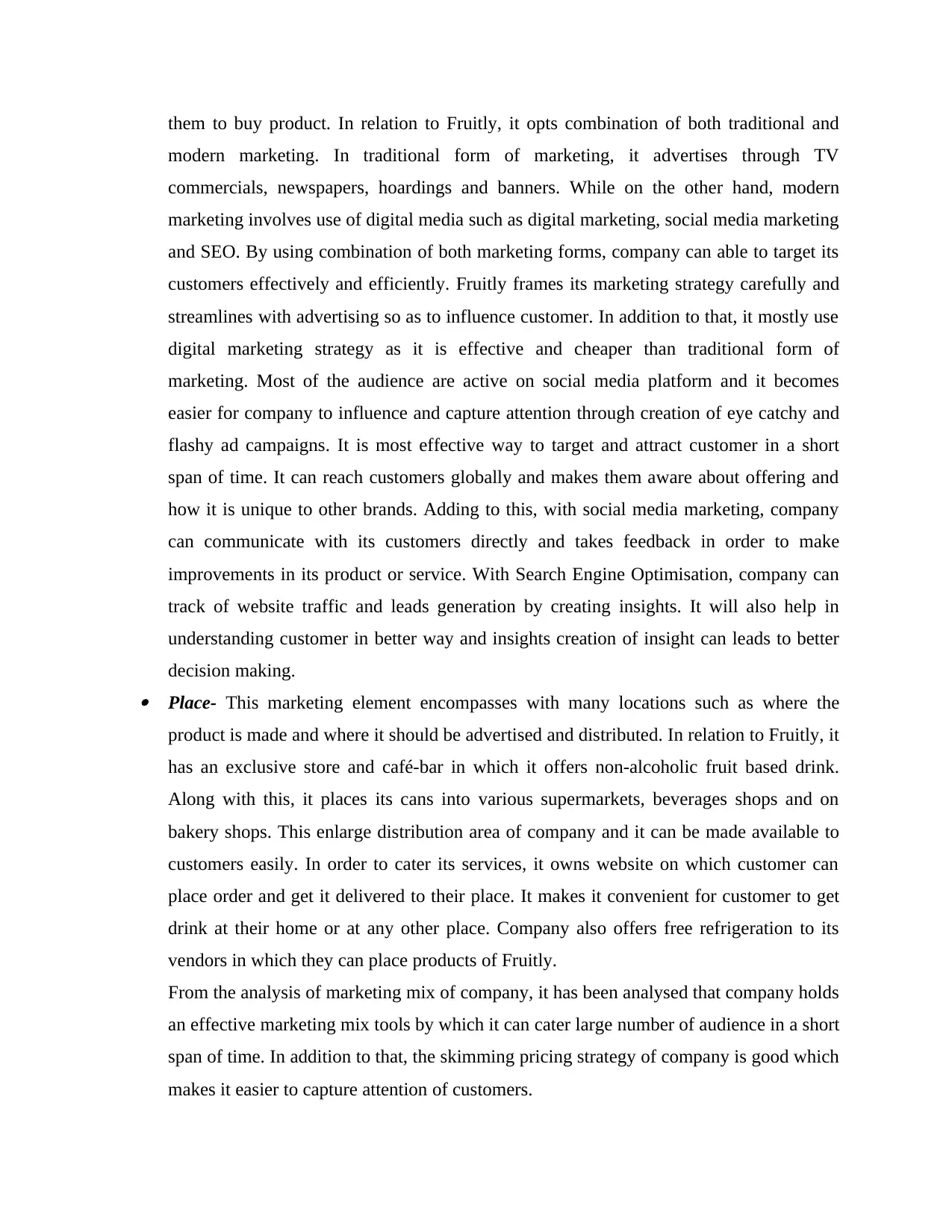
them to buy product. In relation to Fruitly, it opts combination of both traditional and
modern marketing. In traditional form of marketing, it advertises through TV
commercials, newspapers, hoardings and banners. While on the other hand, modern
marketing involves use of digital media such as digital marketing, social media marketing
and SEO. By using combination of both marketing forms, company can able to target its
customers effectively and efficiently. Fruitly frames its marketing strategy carefully and
streamlines with advertising so as to influence customer. In addition to that, it mostly use
digital marketing strategy as it is effective and cheaper than traditional form of
marketing. Most of the audience are active on social media platform and it becomes
easier for company to influence and capture attention through creation of eye catchy and
flashy ad campaigns. It is most effective way to target and attract customer in a short
span of time. It can reach customers globally and makes them aware about offering and
how it is unique to other brands. Adding to this, with social media marketing, company
can communicate with its customers directly and takes feedback in order to make
improvements in its product or service. With Search Engine Optimisation, company can
track of website traffic and leads generation by creating insights. It will also help in
understanding customer in better way and insights creation of insight can leads to better
decision making. Place- This marketing element encompasses with many locations such as where the
product is made and where it should be advertised and distributed. In relation to Fruitly, it
has an exclusive store and café-bar in which it offers non-alcoholic fruit based drink.
Along with this, it places its cans into various supermarkets, beverages shops and on
bakery shops. This enlarge distribution area of company and it can be made available to
customers easily. In order to cater its services, it owns website on which customer can
place order and get it delivered to their place. It makes it convenient for customer to get
drink at their home or at any other place. Company also offers free refrigeration to its
vendors in which they can place products of Fruitly.
From the analysis of marketing mix of company, it has been analysed that company holds
an effective marketing mix tools by which it can cater large number of audience in a short
span of time. In addition to that, the skimming pricing strategy of company is good which
makes it easier to capture attention of customers.
modern marketing. In traditional form of marketing, it advertises through TV
commercials, newspapers, hoardings and banners. While on the other hand, modern
marketing involves use of digital media such as digital marketing, social media marketing
and SEO. By using combination of both marketing forms, company can able to target its
customers effectively and efficiently. Fruitly frames its marketing strategy carefully and
streamlines with advertising so as to influence customer. In addition to that, it mostly use
digital marketing strategy as it is effective and cheaper than traditional form of
marketing. Most of the audience are active on social media platform and it becomes
easier for company to influence and capture attention through creation of eye catchy and
flashy ad campaigns. It is most effective way to target and attract customer in a short
span of time. It can reach customers globally and makes them aware about offering and
how it is unique to other brands. Adding to this, with social media marketing, company
can communicate with its customers directly and takes feedback in order to make
improvements in its product or service. With Search Engine Optimisation, company can
track of website traffic and leads generation by creating insights. It will also help in
understanding customer in better way and insights creation of insight can leads to better
decision making. Place- This marketing element encompasses with many locations such as where the
product is made and where it should be advertised and distributed. In relation to Fruitly, it
has an exclusive store and café-bar in which it offers non-alcoholic fruit based drink.
Along with this, it places its cans into various supermarkets, beverages shops and on
bakery shops. This enlarge distribution area of company and it can be made available to
customers easily. In order to cater its services, it owns website on which customer can
place order and get it delivered to their place. It makes it convenient for customer to get
drink at their home or at any other place. Company also offers free refrigeration to its
vendors in which they can place products of Fruitly.
From the analysis of marketing mix of company, it has been analysed that company holds
an effective marketing mix tools by which it can cater large number of audience in a short
span of time. In addition to that, the skimming pricing strategy of company is good which
makes it easier to capture attention of customers.
Paraphrase This Document
Need a fresh take? Get an instant paraphrase of this document with our AI Paraphraser
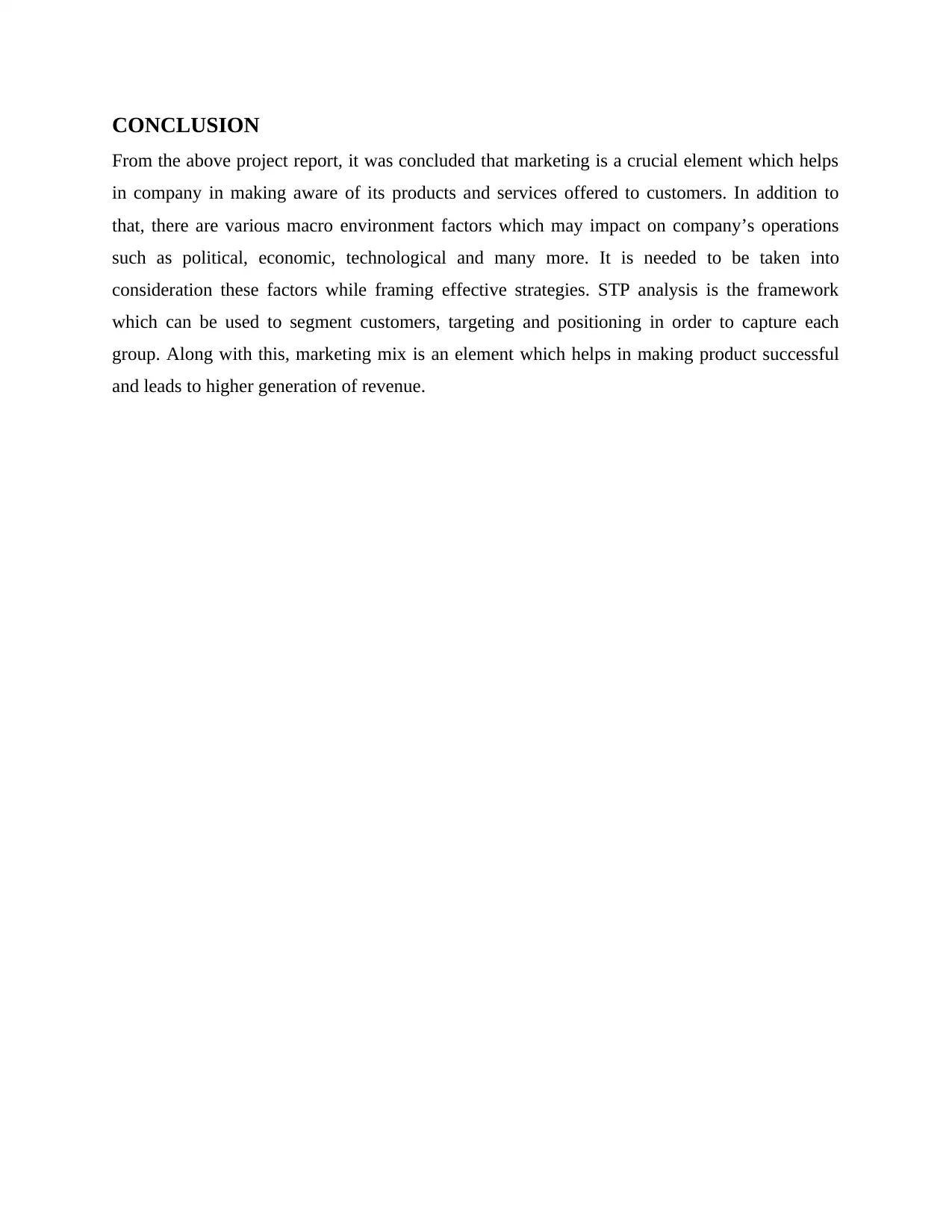
CONCLUSION
From the above project report, it was concluded that marketing is a crucial element which helps
in company in making aware of its products and services offered to customers. In addition to
that, there are various macro environment factors which may impact on company’s operations
such as political, economic, technological and many more. It is needed to be taken into
consideration these factors while framing effective strategies. STP analysis is the framework
which can be used to segment customers, targeting and positioning in order to capture each
group. Along with this, marketing mix is an element which helps in making product successful
and leads to higher generation of revenue.
From the above project report, it was concluded that marketing is a crucial element which helps
in company in making aware of its products and services offered to customers. In addition to
that, there are various macro environment factors which may impact on company’s operations
such as political, economic, technological and many more. It is needed to be taken into
consideration these factors while framing effective strategies. STP analysis is the framework
which can be used to segment customers, targeting and positioning in order to capture each
group. Along with this, marketing mix is an element which helps in making product successful
and leads to higher generation of revenue.
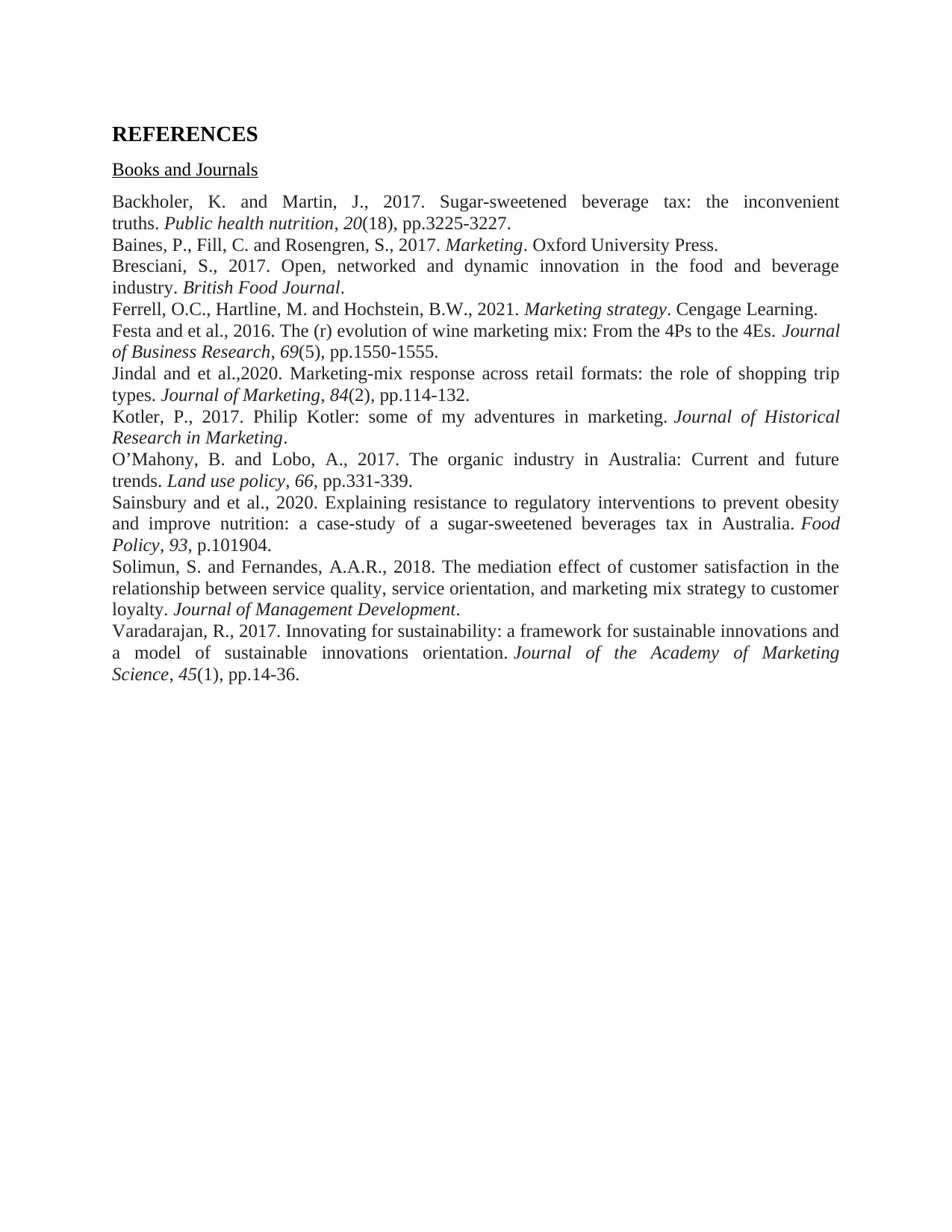
REFERENCES
Books and Journals
Backholer, K. and Martin, J., 2017. Sugar-sweetened beverage tax: the inconvenient
truths. Public health nutrition, 20(18), pp.3225-3227.
Baines, P., Fill, C. and Rosengren, S., 2017. Marketing. Oxford University Press.
Bresciani, S., 2017. Open, networked and dynamic innovation in the food and beverage
industry. British Food Journal.
Ferrell, O.C., Hartline, M. and Hochstein, B.W., 2021. Marketing strategy. Cengage Learning.
Festa and et al., 2016. The (r) evolution of wine marketing mix: From the 4Ps to the 4Es. Journal
of Business Research, 69(5), pp.1550-1555.
Jindal and et al.,2020. Marketing-mix response across retail formats: the role of shopping trip
types. Journal of Marketing, 84(2), pp.114-132.
Kotler, P., 2017. Philip Kotler: some of my adventures in marketing. Journal of Historical
Research in Marketing.
O’Mahony, B. and Lobo, A., 2017. The organic industry in Australia: Current and future
trends. Land use policy, 66, pp.331-339.
Sainsbury and et al., 2020. Explaining resistance to regulatory interventions to prevent obesity
and improve nutrition: a case-study of a sugar-sweetened beverages tax in Australia. Food
Policy, 93, p.101904.
Solimun, S. and Fernandes, A.A.R., 2018. The mediation effect of customer satisfaction in the
relationship between service quality, service orientation, and marketing mix strategy to customer
loyalty. Journal of Management Development.
Varadarajan, R., 2017. Innovating for sustainability: a framework for sustainable innovations and
a model of sustainable innovations orientation. Journal of the Academy of Marketing
Science, 45(1), pp.14-36.
Books and Journals
Backholer, K. and Martin, J., 2017. Sugar-sweetened beverage tax: the inconvenient
truths. Public health nutrition, 20(18), pp.3225-3227.
Baines, P., Fill, C. and Rosengren, S., 2017. Marketing. Oxford University Press.
Bresciani, S., 2017. Open, networked and dynamic innovation in the food and beverage
industry. British Food Journal.
Ferrell, O.C., Hartline, M. and Hochstein, B.W., 2021. Marketing strategy. Cengage Learning.
Festa and et al., 2016. The (r) evolution of wine marketing mix: From the 4Ps to the 4Es. Journal
of Business Research, 69(5), pp.1550-1555.
Jindal and et al.,2020. Marketing-mix response across retail formats: the role of shopping trip
types. Journal of Marketing, 84(2), pp.114-132.
Kotler, P., 2017. Philip Kotler: some of my adventures in marketing. Journal of Historical
Research in Marketing.
O’Mahony, B. and Lobo, A., 2017. The organic industry in Australia: Current and future
trends. Land use policy, 66, pp.331-339.
Sainsbury and et al., 2020. Explaining resistance to regulatory interventions to prevent obesity
and improve nutrition: a case-study of a sugar-sweetened beverages tax in Australia. Food
Policy, 93, p.101904.
Solimun, S. and Fernandes, A.A.R., 2018. The mediation effect of customer satisfaction in the
relationship between service quality, service orientation, and marketing mix strategy to customer
loyalty. Journal of Management Development.
Varadarajan, R., 2017. Innovating for sustainability: a framework for sustainable innovations and
a model of sustainable innovations orientation. Journal of the Academy of Marketing
Science, 45(1), pp.14-36.
⊘ This is a preview!⊘
Do you want full access?
Subscribe today to unlock all pages.

Trusted by 1+ million students worldwide
1 out of 12
Related Documents
Your All-in-One AI-Powered Toolkit for Academic Success.
+13062052269
info@desklib.com
Available 24*7 on WhatsApp / Email
![[object Object]](/_next/static/media/star-bottom.7253800d.svg)
Unlock your academic potential
Copyright © 2020–2025 A2Z Services. All Rights Reserved. Developed and managed by ZUCOL.





